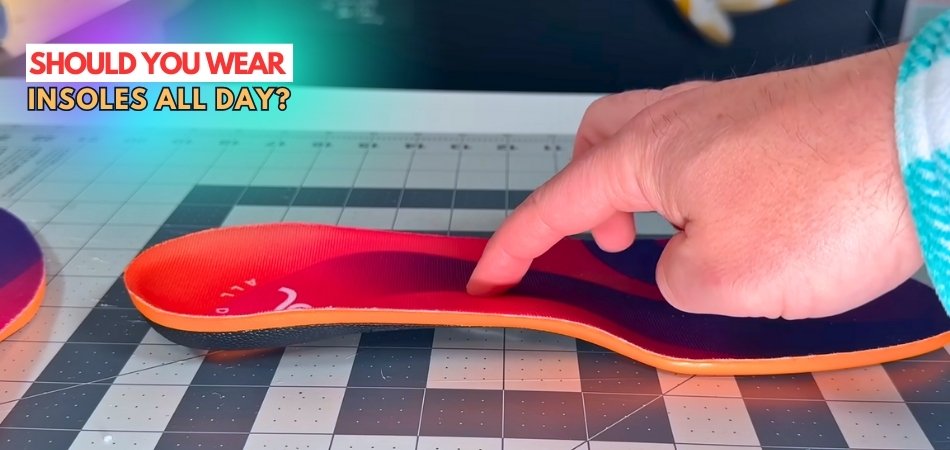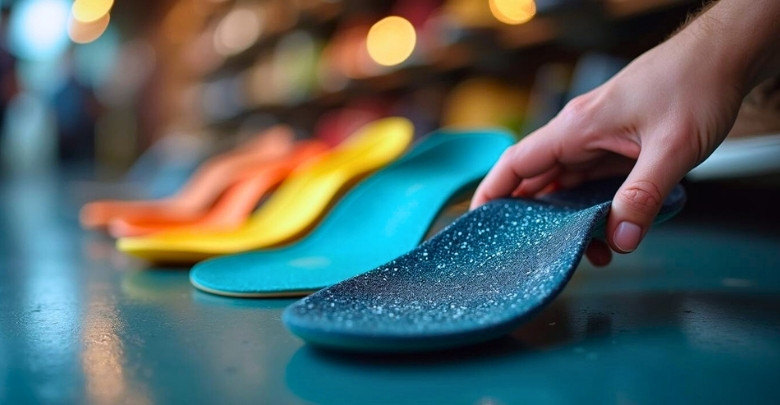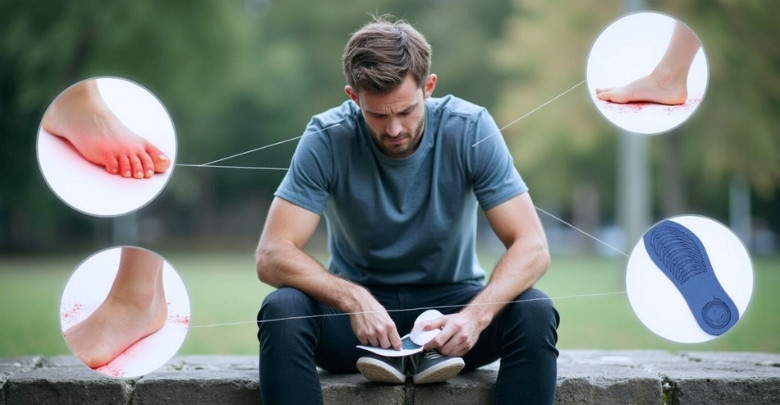Adding an insole to your shoes can improve comfort and support, alleviate foot pain, and improve posture. But when it comes to wearing them for long periods of time, many wonder: Should you wear insoles all day?
Yes, you can wear insoles all day once you’ve adjusted to them. Start gradually to allow your feet to adapt and avoid discomfort. Over time, insoles can improve comfort, support, posture, and reduce foot pain.
This gradual approach ensures your feet can adapt to the added support. The following articles will provide you with more information about the benefits of wearing insoles and tips on how to use them effectively.
Should You Wear Insoles All Day?
Definitely, you can wear insoles all day but gradually increase their wear time. Insoles provide various benefits for foot health, posture, and comfort. However, starting slow is key to avoiding discomfort. Here are some benefits of wearing insoles:

Enhances Foot Support
Proper support keeps your feet aligned and reduces pressure on key areas. Insoles provide stability, preventing discomfort during long hours of standing or walking. They help distribute weight evenly, reducing strain on the arches and heels. Wearing them daily can improve overall foot posture and comfort.
Reduces Foot Fatigue
Tired feet often lead to pain, especially after long days on hard surfaces. Insoles absorb impact and cushion each step, preventing discomfort. By reducing strain, they help keep feet energized throughout the day. Less fatigue means better mobility and reduced risk of foot-related issues.
Improves Posture and Balance
Good posture starts with proper foot alignment, which insoles help maintain. Better posture reduces stress on joints and minimizes back pain. Enhanced balance lowers the risk of falls and injuries. Insoles contribute to better weight distribution, preventing uneven pressure on the body.
Prevents Common Foot Problems
Insoles help in reducing the risk of plantar fasciitis, shin splints, and flat feet discomfort. By offering extra arch support, they ease the strain on sensitive areas. Branded products such as soul insole provide specialized designs to improve the health of your feet. By regularly using this, you can avoid chronic pain issues before they develop.
Enhances Shoe Comfort
Many shoes lack proper support, making insoles a great addition. They add cushioning, making even hard-soled shoes more comfortable. Soft padding reduces friction and prevents blisters. Wearing insoles daily transforms regular footwear into a more supportive option.
Supports Active Lifestyles
For people who stand, walk, or exercise often, insoles provide extra shock absorption. Athletes and active individuals benefit from reduced impact on joints. Supportive insoles minimize strain and allow longer activity sessions. Keeping feet comfortable enhances overall movement and performance.
What to Look for in a High-Quality Insole?
A high-quality insole can make a huge difference in comfort and foot health. With so many options available, choosing the right insoles is key. Here are some things to keep in mind when searching for insoles to ensure long-term comfort and support.

- Material Quality: High-quality insoles are made from durable materials like memory foam, gel, or EVA. These materials provide cushioning and impact resistance.
- Arch Support: Good insoles offer firm arch support that aligns with the natural shape of your foot. This reduces foot pain and discomfort.
- Cushioning: Look for insoles with adequate cushioning to absorb shock during walking or standing. Soft yet supportive cushioning improves overall comfort.
- Breathability: Breathable materials help prevent moisture buildup, keeping your feet cool and dry. This reduces the risk of unpleasant odors and discomfort.
- Durability: Insoles should retain their shape and support over time. Check for wear resistance to ensure they last through heavy use.
- Fit and Size: Properly fitted insoles prevent slipping and shifting inside your shoes. Custom-sized insoles offer better support, preventing unnecessary foot strain.
- Heel Cup: A well-designed heel cup provides additional support and helps align the feet. It keeps the foot stable, preventing excessive movement.
- Anti-slip Features: Choose insoles with anti-slip features to keep them in place throughout the day. This ensures they don’t move while you’re walking.
Custom vs. Over-the-Counter Insoles: Which One is Better?
When it comes to choosing insoles, it can be difficult to decide between custom and over-the-counter options. Depending on your foot health and needs, both types have advantages. To make an informed decision, let’s compare the key differences between custom and over-the-counter insoles:
| Criteria | Custom Insoles | Over-the-Counter Insoles |
| Fit | Made specifically for your foot’s unique shape. | Standardized fit for most foot shapes. |
| Cost | Typically more expensive due to customization. | More affordable, available at various price points. |
| Comfort | Designed for optimal comfort based on foot shape. | Comfort can vary; and may require adjustment. |
| Durability | High-quality materials that last longer. | Quality varies; may need replacement sooner. |
| Foot Health Benefits | Ideal for addressing specific foot problems. | Suitable for general comfort and support. |
| Customization | Designed to address specific conditions (e.g., plantar fasciitis). | Limited customization, usually one-size-fits-all. |
| Ease of Use | Requires professional fitting, which can be time-consuming. | Ready to use immediately without appointments. |
| Adjustability | Can be adjusted over time for better fit. | Usually not adjustable after purchase. |
| Material Variety | Uses premium, medical-grade materials. | Made from a range of materials, less specialized. |
| Insurance Coverage | Often covered by insurance if medically prescribed. | Not covered by insurance. |
Do You Need Different Insoles for Different Activities?
Yes, different activities require different insoles to provide the right support and comfort. Each activity places unique pressure on your feet, affecting posture and stability. Using specialized insoles helps reduce strain and prevent discomfort during various movements.
Walking insoles offer soft cushioning for everyday comfort and support. Running insoles absorb shock, reducing stress on joints and muscles with each step. Hiking insoles provide extra arch support and durability for rough terrains and long-distance walks.
Work insoles help those who stand for long hours by easing foot fatigue. Sports insoles enhance performance by improving stability and reducing impact on joints. Casual insoles focus on all-day wear, keeping feet comfortable during routine activities.
Wearing the right insoles improves comfort, reduces pain, and supports overall foot health. Choosing insoles designed for your activities prevents injuries and enhances movement. Investing in proper insoles ensures better support for daily tasks and sports.
How to Know If Your Insoles Are Causing Discomfort?
Insoles are designed to improve comfort and support, but sometimes they can cause discomfort. If you’re experiencing pain or unease, it’s important to figure out what’s wrong. Let’s explore signs that your insoles might be causing discomfort.

Persistent Foot Pain
Foot pain that starts after wearing insoles may indicate poor fit or lack of support. Uncomfortable pressure points can lead to soreness and discomfort. If pain worsens over time, the insoles may not be right for your feet. Switching to a better fit can relieve unnecessary strain.
Uneven Pressure on Feet
Insoles should distribute weight evenly to prevent stress in certain areas. Uneven pressure can cause discomfort and make walking difficult. Feeling strain in the heels or arches suggests improper alignment. Adjusting or replacing insoles can restore comfort and balance.
Slipping or Shifting Inside Shoes
Insoles should stay in place while walking or standing. If they slip, they may not fit your shoes properly. Frequent shifting can cause blisters or irritation. Secure-fitting insoles improve stability and prevent unnecessary movement inside shoes.
Increased Fatigue While Walking
Tired or aching feet after short walks may indicate poorly cushioned insoles. Lack of shock absorption increases strain on muscles and joints. Properly cushioned insoles reduce impact and improve overall comfort. If fatigue persists, consider switching to a more supportive option.
Development of Calluses or Blisters
Ill-fitting insoles can cause friction, leading to blisters or calluses. Pressure on specific areas creates skin irritation over time. Comfortable insoles should reduce friction, not create discomfort. By using soul insoles, you can prevent unnecessary rubbing on the feet and improve your overall comfort.
Difficulty Adjusting Over Time
New insoles may take time to adjust, but discomfort should not last long. Ongoing pain suggests the insoles are not suitable. Feet should feel supported without strain after a short break-in period. Persistent discomfort means trying a different style or fit may be necessary.
FAQs About Should You Wear Insoles All Day?
Many people have questions about how to use insoles properly for foot comfort, support, and pain relief. Whether you’re new to insoles or looking to optimize your experience, understanding the right way to use them is important. Here are some frequently asked questions to help you make the most of your insoles.
How Long Does It Take to Adjust to Insoles?
Most people take about one to two weeks to fully adjust to new insoles. Start by wearing them for a few hours daily and gradually increase wear time. This allows your feet to adapt without unnecessary strain. If the discomfort lasts longer, reassess the fit and support level.
Do Insoles Wear Out Over Time?
Yes, insoles wear out and lose their effectiveness over time due to regular use. Most over-the-counter insoles last around six months, while high-quality or custom ones may last longer. Check for signs of wear, like thinning material or reduced cushioning. Replacing worn-out insoles ensures continued foot support and comfort.
Do Insoles Help with Back and Knee Pain?
Yes, properly designed insoles can help alleviate back and knee pain by improving foot alignment and posture. Insoles that offer arch support and cushioning reduce stress on the joints. Correcting foot positioning can prevent strain that leads to discomfort in other body parts. This makes them beneficial for overall body posture and movement.
Are Gel Insoles Better Than Foam Insoles?
It depends on your needs—gel insoles provide excellent shock absorption, while foam insoles offer more arch support. Gel insoles are great for high-impact activities, reducing stress on joints. Foam insoles work well for long-term comfort and posture improvement. Choosing the right type depends on your lifestyle and foot condition.
Do Insoles Help with Sweaty Feet?
Yes, breathable insoles made from moisture-wicking materials help reduce sweat buildup. Insoles with ventilation holes or anti-microbial coatings prevent odor and keep feet dry. Avoid using non-breathable materials that trap moisture inside the shoe. Choosing high-quality insoles can improve comfort for people with sweaty feet.
Are Custom Insoles Worth the Extra Cost?
Custom insoles are beneficial if you have specific foot conditions like plantar fasciitis or flat feet. They provide specific support, offering better comfort and alignment. While expensive, they last longer and provide better relief than standard insoles. For general comfort, high-quality over-the-counter insoles may suffice.
Final Thoughts
Insoles can significantly improve foot comfort, support, and posture, but it’s essential to use them correctly. If you still wonder, should you wear insoles all day? the answer is yes. However, it’s important to start gradually to allow your feet to adjust. Insoles can enhance comfort, reduce fatigue, improve posture, and prevent common foot problems.
Over time, they help support active lifestyles and alleviate discomfort. However, it’s essential to pay attention to any discomfort, as improper fit can lead to issues like foot pain or blisters. Finding the right insoles, whether custom or over-the-counter, tailored for specific activities, ensures the best results. With the right adjustments, insoles can make a noticeable difference in your foot health and comfort.






